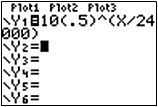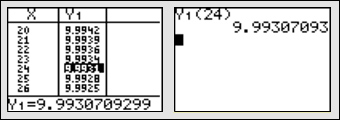 represents the amount of Plutonium-239 that remains after x years, how much of the Plutonium-239 remains in the year 2010?
represents the amount of Plutonium-239 that remains after x years, how much of the Plutonium-239 remains in the year 2010? This section provides two problems to practice solving contextual exponential expressions.
One common phenomenon that is typically modeled by exponential decay functions is half-life, which is the period of time it takes for one-half of a substance undergoing decay to decay into another substance.
In 1986, a nuclear reactor accident occurred in Chernobyl (which was then part of the Soviet Union.) The explosion caused the spread of highly toxic radioactive chemicals, making the region uninhabitable and forcing an evacuation. If 10 pounds of Plutonium-239, P, were initially released into the atmosphere with the explosion in 1986 and the function  represents the amount of Plutonium-239 that remains after x years, how much of the Plutonium-239 remains in the year 2010?
represents the amount of Plutonium-239 that remains after x years, how much of the Plutonium-239 remains in the year 2010?
Do you think the region will be re-inhabitable in your lifetime? Why or why not?
Interactive popup. Assistance may be required. Enter the given exponential function into Y1.


Americans purchase billions of bottles of water each year. The data in the table below shows the number of plastic bottled water sold, in billions, from 1996 to 2006.
| Year |
(in billions) |
| 1996 | 3.0 |
| 1997 | 3.6 |
| 1998 | 4.9 |
| 1999 | 6.4 |
| 2000 | 9.0 |
| 2001 | 11.1 |
| 2002 | 14.9 |
| 2003 | 16.8 |
| 2004 | 24.0 |
| 2005 | 28.2 |
| 2006 | 36.0 |
If Americans continue to purchase bottled water at this same rate, what is your prediction for the number of bottles that will be sold in the year 2015?
Interactive popup. Assistance may be required. The number of plastic bottles of water sold in 2015 will be approximately 370 billion!
